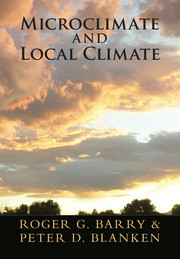Book contents
10 - Urban Climates
from Part II - Local (Topo-)Climates
Published online by Cambridge University Press: 05 May 2016
Summary
Urban climatic characteristics are becoming a topic of increased importance, given that more than half the world's population now resides in cities. The building architecture, urban design, and building materials all influence the temperature, humidity, and wind conditions. Heat released by buildings and pollutants from traffic and industries modify the city environment. Urban microclimates are discussed in Chapter 8, Section E. Here we focus on the regional-scale characteristics.
Research into urban climates began with climatic measurements made in the early nineteenth century at a site in the city and three sites around London by Luke Howard. The first edition of his book on the climate of London was published in 1818–20. Mills (2008) describes Howard's major contribution to identifying the urban heat island. An example of a circa 1925 urban weather station is shown in Figure 10.1. More than a century later, Tony Chandler (1965) used station data and nighttime transects made with an instrumented vehicle to analyze the heat island of London. By reversing the route and averaging the two sets of data he was able to determine the climatic conditions across London. Helmut Landsberg (1981) published The urban climate, which drew particular attention to pollution aerosols.
There are three components involved in the production of urban climates. These are (i) modification of the atmospheric composition, (ii) modification of the surface energy budget, and (iii) modification of the surface characteristics. The second and third of these modifications are responsible for the development of the urban heat island (UHI).
Modification of Atmospheric Composition
The urban atmosphere contains a complex mix of gases and particles in concentrations that differ considerably from those in rural environments. The gases include ozone, sulfur dioxide, carbon monoxide, and nitric oxides. The particles include carbon, complex hydrocarbons, metals, and mineral dust. These are now discussed in turn.
Gases
Industrial and domestic coal burning generates sulfur dioxide (SO2), while the combustion of gasoline and oil produces hydrocarbons (Hc), carbon monoxide (CO), nitrogen oxides (NOx), and ozone (O3). Seinfeld (1989) cites data from 39 U.S. cities during 1984–6 that list concentrations for 48 gaseous compounds: 25 were paraffins, 15 aromatics, and 7 biogenic olefins. The sum of the median concentrations for the paraffins was 266 ppbC, representing 60 percent of the total 48 compounds.
- Type
- Chapter
- Information
- Microclimate and Local Climate , pp. 243 - 260Publisher: Cambridge University PressPrint publication year: 2016
References
- 1
- Cited by



